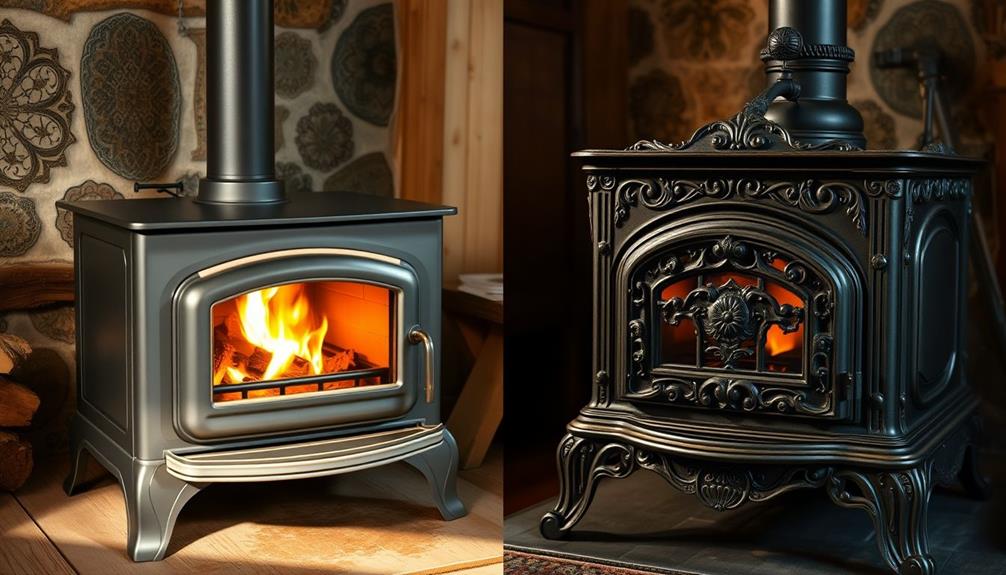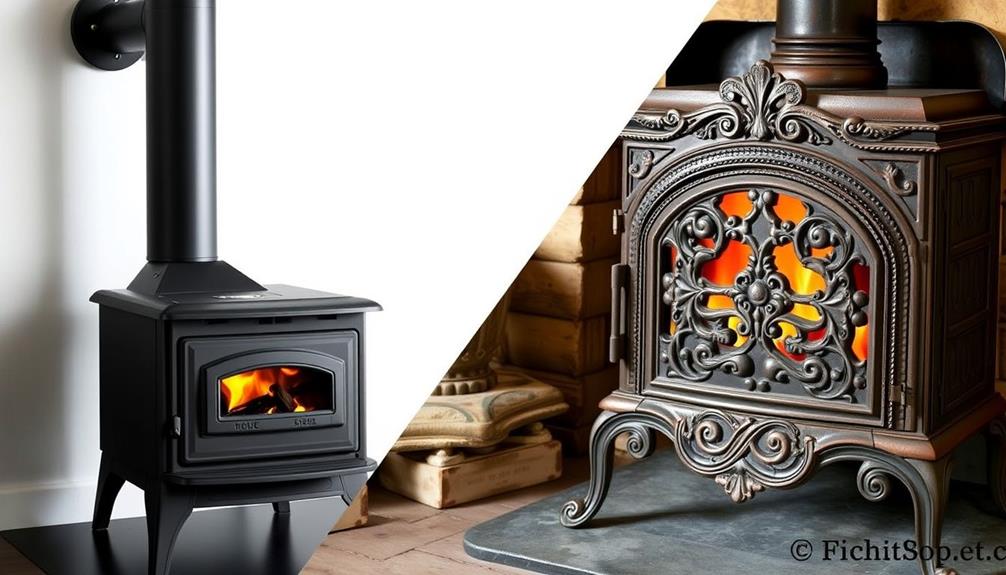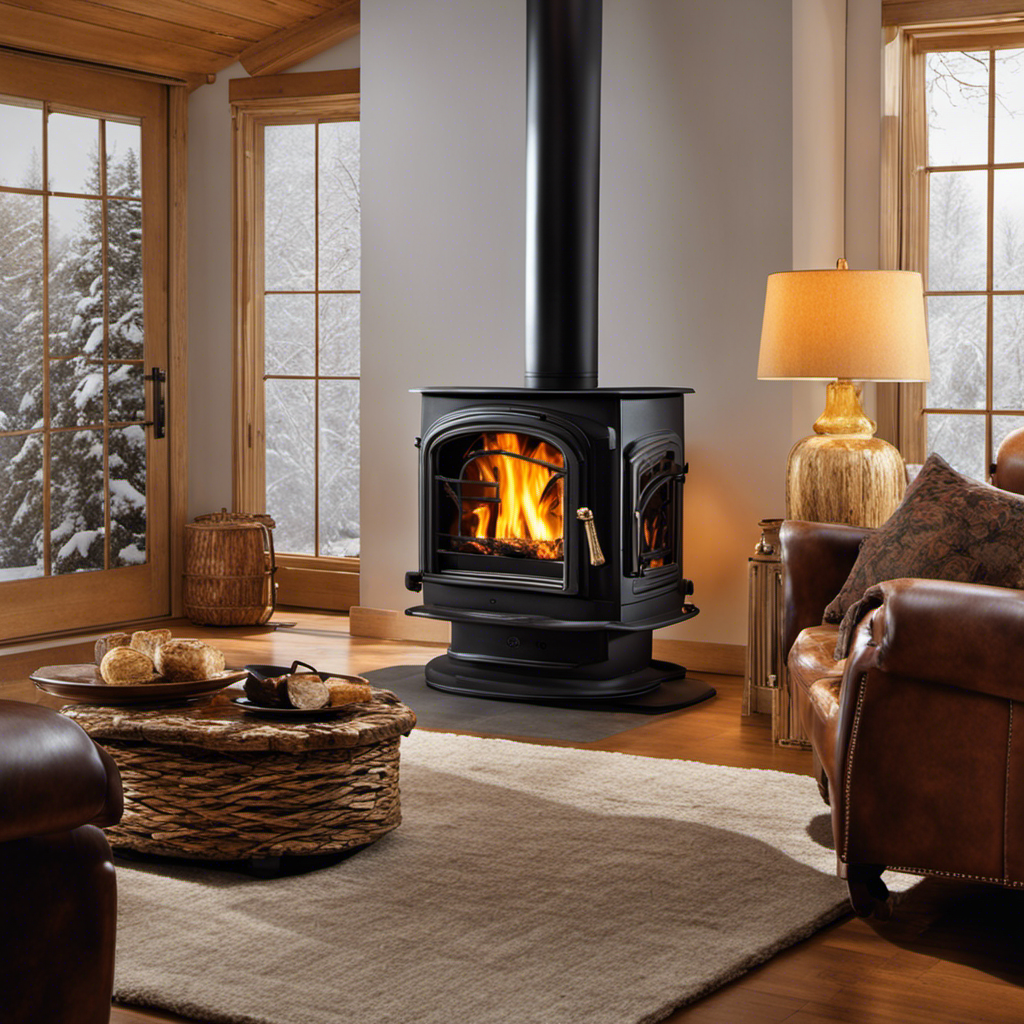When choosing between steel and cast iron wood stoves, each has its strengths. Cast iron excels in heat retention and longevity, providing steady warmth and lasting generations with proper care. On the other hand, steel heats up quickly for immediate warmth but cools down faster, and it generally has a shorter lifespan. If you prefer a traditional look, cast iron offers ornate designs, while steel provides a sleek, modern finish. Consider your heating needs, maintenance preferences, and budget before deciding. There's plenty more to explore about these stoves and how they fit into your home heating strategy.
Key Takeaways
- Cast iron stoves offer superior heat retention and longevity, often lasting generations with proper care, while steel stoves heat up quickly but cool down faster.
- Steel stoves are generally more budget-friendly, costing between $800 and $2,000, while cast iron stoves range from $1,500 to $3,000.
- Cast iron provides a traditional aesthetic with intricate designs, whereas steel offers a sleek, modern look with customization options.
- Maintenance for cast iron stoves includes regular seasoning and crack inspections, while steel requires occasional paint touch-ups to prevent corrosion.
- Safety considerations differ, as steel stoves can reach higher surface temperatures, necessitating careful usage and regular inspections for both types.
Understanding Wood Stove Efficiency
When it comes to wood stove efficiency, many models can achieve impressive ratings, often reaching up to 80%. This high efficiency rating indicates a stove's ability to burn wood cleanly and completely, which is essential for maximizing heat output while minimizing emissions.
Factors like air supply and moisture content in the wood can greatly affect this performance. Additionally, proper maintenance practices, like ensuring a clean and well-functioning stove, can enhance efficiency and safety, as seen in clogging remedies.
One key aspect to take into account is heat retention. Cast iron stoves excel in this area, holding onto heat much longer than their counterparts. This means that even after the fire dies down, you can still enjoy a warm room for hours.
On the other hand, steel stoves heat up quickly, providing immediate warmth, but they may not retain heat as effectively.
As consumer awareness of wood stove efficiency grows, many are seeking models that comply with modern emissions standards, such as the 2022 Ecodesign regulations.
If you're in the market for a wood stove, understanding these differences between cast iron vs. steel can help you make a well-informed choice that aligns with your heating needs and environmental goals.
Material Comparison: Cast Iron and Steel

When choosing between cast iron and steel wood stoves, you'll notice key differences in durability, heat retention, and design.
Cast iron stoves excel in longevity and heat retention, while steel models heat up quickly and can offer a modern aesthetic.
Additionally, the BTU rating of models like the Englander 10-Cpm can influence your decision, as higher output may be essential for larger spaces.
Your choice will depend on what matters most to you regarding performance and style.
Durability and Longevity
How do cast iron and steel wood stoves stack up concerning durability and longevity?
When it comes to durability, cast iron stoves are often regarded as the champions. With proper maintenance, they can last for generations, resisting warping and cracking over time. Additionally, many homeowners appreciate the innovative design of cast iron stoves, which often enhances both functionality and aesthetics.
On the other hand, steel stoves typically have a shorter lifespan due to their thinner construction. While steel can handle repeated hot-cold cycles without cracking, it's still not as enduring as cast iron.
The quality of the materials plays a significant role in their longevity. High-quality cast iron stoves are built to withstand higher temperatures and maintain their structural integrity, though lower-grade options may have weaknesses.
Steel's durability varies depending on the alloy and treatment used, so choosing a reputable brand is essential.
Regardless of your choice, regular maintenance is key. Seasoning your cast iron stove and performing touch-ups on your steel stove will help guarantee peak performance and longevity.
Heat Retention Properties
Both cast iron and steel wood stoves offer distinct heat retention properties that cater to different heating needs.
If you're looking for consistent warmth, cast iron stoves excel due to their ability to absorb heat slowly and radiate it over an extended period, even after the fire has died down. This makes them ideal for prolonged heating, maintaining a stable temperature throughout the night.
Additionally, the efficiency of heat transfer in these stoves can be influenced by their design and materials, which is similar to how thermal energy transfer basics play a significant role in heat pump performance.
On the other hand, steel stoves heat up quickly, providing immediate warmth for quick heating needs. However, they cool down faster once the fire is out, which can be a downside if you prefer longer-lasting heat retention.
Here are three key points to take into account when evaluating heat retention properties:
- Prolonged Heat Output: Cast iron stoves provide steady, long-lasting warmth.
- Quick Heating: Steel stoves offer immediate warmth but for a shorter duration.
- Durability: While cast iron can crack under extreme heat, steel stoves handle temperature fluctuations better.
Ultimately, your choice between cast iron and steel stoves will depend on your specific heating preferences and needs.
Aesthetic Design Options
Choosing the right wood stove goes beyond functionality; it also involves considering the aesthetic design that best fits your home.
When you explore aesthetic design options, cast iron and steel stoves offer distinct styles that cater to different tastes. Cast iron stoves often showcase intricate, ornate designs born from the casting process, making them perfect for those who appreciate a classic and traditional look. Their weight and bulkiness contribute to a robust, rustic appearance that can enhance the cozy ambiance of your space, reminiscent of modern farmhouse decor trends.
Additionally, integrating natural materials and vintage elements can complement the warmth of cast iron stoves.
On the other hand, steel stoves provide a clean, contemporary look, allowing for sleek and varied shapes that seamlessly integrate into modern interiors. You can easily customize steel stoves with painted finishes to match your decor, giving you flexibility in design.
While cast iron ages beautifully and retains heat, enhancing its visual appeal over time, steel may require touch-ups to maintain its finish.
Ultimately, your choice between cast iron and steel stoves should reflect your personal style and how you want your wood stove to complement your home's aesthetic.
Aesthetic Appeal of Each Material

While you consider the aesthetic appeal of wood stoves, it's essential to recognize the distinct charm offered by cast iron and steel. Each material brings its own unique style to your living space, influencing the overall ambiance. For those looking to enhance their home with rustic elements, a farmhouse front door can complement the vintage allure of a cast iron stove beautifully.
1. Cast Iron: This material often features intricate, ornate designs, appealing to those who seek a traditional and rustic feel. Its heavier, chunkier appearance contributes to a classic aesthetic that can evoke vintage charm and craftsmanship.
However, be aware that potential cracking might compromise its visual integrity over time.
2. Steel: In contrast, steel wood stoves provide a clean, contemporary look. They offer customization options, such as painted finishes, allowing you to match various interior decor styles seamlessly.
Their streamlined appearance can create a modern vibe in your home.
3. Ambiance: Both materials can enhance the ambiance of a room. If you value vintage charm and craftsmanship, cast iron might be your choice.
If you prefer a sleek and adaptable design, then steel is likely the better fit.
Ultimately, your decision depends on which aesthetic appeals more to your personal style and the atmosphere you want to create in your home.
Cost and Economic Factors

When you're considering wood stoves, the initial purchase price is just the starting point.
While cast iron models might hit your wallet harder at first, their long-term savings and efficiency can make them a smart investment.
Additionally, factors like the reputation and reviews from past clients can also influence your choice of stove, as they reflect durability and performance over time.
Don't forget about installation costs either; those can vary considerably between steel and cast iron stoves, impacting your overall budget.
Initial Purchase Price
The initial purchase price of wood stoves can significantly impact your budget and overall heating strategy. When considering whether to invest in a cast iron or steel stove, it's important to compare their prices.
Cast iron stoves usually come with a higher initial purchase price, ranging from $1,500 to $3,000. This is largely due to the cost of materials and the complex manufacturing processes involved. Additionally, factors such as astrological compatibility may influence your choice, as personal beliefs about energy and environment can play a role in purchasing decisions.
On the other hand, steel stoves present a more budget-friendly option, typically priced between $800 and $2,000.
Here's a quick breakdown of what to keep in mind:
- Cost of materials: Cast iron stoves use heavier, more expensive materials compared to steel.
- Manufacturing complexity: The production process for cast iron is more intricate, leading to higher prices.
- Access to consumers: Steel stoves often cater to a broader audience due to their affordability.
Ultimately, your choice between cast iron and steel stoves will hinge on your initial purchase price considerations. By weighing these factors, you can make an informed decision that aligns with your financial situation and heating needs.
Long-term Savings Potential
After considering the initial purchase price, it's important to evaluate the long-term savings potential of cast iron versus steel wood stoves. While cast iron stoves typically come with a higher upfront cost, their durability can lead to significant long-term savings. These stoves often last for generations with proper care, meaning you won't have to replace them frequently.
Additionally, similar to how butter enhances flavor in cooking, cast iron stoves enhance heating efficiency, making them a worthwhile investment. On the other hand, steel stoves are generally more budget-friendly at the beginning, making them appealing for those looking to save money now. However, they often don't hold their value as well over time.
Cast iron stoves also boast higher efficiency ratings, sometimes reaching up to 80%. This efficiency can lower your heating bills, providing further long-term savings compared to steel stoves.
Additionally, maintenance costs for cast iron stoves can be lower as they require less frequent repairs and replacements, especially when made from high-quality materials. Investing in a compliant, high-quality stove may also open doors to energy efficiency rebates, enhancing your economic returns.
In the end, when considering long-term savings, cast iron stoves often emerge as the more cost-effective option.
Installation Cost Differences
Installing a wood stove can considerably impact your overall costs, and many factors come into play. When it comes to installation costs, you'll find that choosing between cast iron and steel stoves can make a significant difference in your budget.
1. Weight and Complexity: Cast iron stoves are heavier and often require more labor for installation. This can lead to higher costs, especially if you need to reinforce your flooring.
Additionally, ensuring proper ventilation during use is essential, as it can affect both safety and installation requirements safety precautions necessary.
2. Ease of Handling: Steel stoves, being lighter, are generally easier to install. Their lightweight design allows for quicker setups, which can save you on labor costs.
3. Regional Variations: Installation costs can also vary by region. In areas with higher labor rates, the difference in installation costs between cast iron and steel stoves can be more pronounced.
Additionally, cast iron installations may require specialized tools or equipment, further increasing your expenses.
By opting for a steel stove, you might avoid extensive modifications to your home, leading to potential savings.
Maintenance and Care Differences

Maintaining your wood stove is essential for peak performance, and the care requirements differ greatly between cast iron and steel models. Cast iron stoves need regular seasoning to protect against rust and periodic inspections for cracks due to their brittleness. On the other hand, steel stoves require less maintenance, with just occasional touch-ups to their paint to prevent corrosion.
Here's a quick comparison of maintenance needs:
| Maintenance Aspect | Cast Iron Stoves |
|---|---|
| Surface Protection | Requires regular seasoning |
| Inspections | Frequent checks for cracks |
| Replacement Parts | Often specialized and costly |
| Aesthetic Care | Needs consistent attention |
| Maintenance Aspect | Steel Stoves |
| Surface Protection | Occasional paint touch-ups |
| Inspections | Less frequent checks |
| Replacement Parts | Generally accessible and affordable |
| Aesthetic Care | Minimal attention needed |
Both types benefit from consistent cleaning to guarantee peak performance. Proper maintenance practices can greatly prolong the lifespan and efficiency of your stove, so be sure to consult your user manual for specific care guidelines.
Heating Characteristics and Performance

When it comes to heating characteristics and performance, you'll find that cast iron and steel wood stoves offer distinct advantages based on your needs.
Cast iron stoves excel at retaining heat, providing a consistent warmth for extended periods. On the other hand, steel stoves heat up quickly, delivering immediate warmth once you light them.
Here's a quick comparison of their heating characteristics:
- Heat Output: Cast iron stoves provide a gradual heat output, making them perfect for sustained heating. Steel stoves, however, can radiate heat more effectively due to their design and mass.
- Heat Retention: While cast iron retains heat longer, steel stoves can withstand repeated hot-cold cycles without significant damage, ensuring a reliable performance over time.
- Efficiency: High-quality steel models, like the P Series Harman stoves, are recognized for their superior heat radiation efficiency compared to traditional cast iron stoves, such as the XXV.
Ultimately, your choice will depend on whether you prioritize immediate warmth or prolonged heating.
Durability and Safety Considerations

The durability and safety of your wood stove can considerably impact your heating experience. When choosing between cast iron and steel, it's essential to reflect on how these materials perform under various conditions.
| Feature | Cast Iron | Steel |
|---|---|---|
| Brittleness | More brittle, can crack | More flexible, less prone to cracking |
| Lifespan | Can last generations | Generally shorter lifespan |
| Repairability | Difficult to repair | Easier to weld and fix |
| Surface Temperature | Stays cooler to touch | Reaches high temperatures quickly |
| Maintenance | Needs regular inspections | Requires maintenance to prevent corrosion |
Cast iron stoves can offer excellent longevity if maintained properly, while steel stoves are easier to repair when issues arise. However, the higher surface temperatures of steel can pose burn hazards, making safety a key factor. Regular inspections are essential for both types to guarantee they operate safely and effectively. By weighing these durability and safety aspects, you can make a more informed decision that suits your heating needs.
Making the Right Choice

Choosing the right wood stove can greatly enhance your heating experience, so it's vital to weigh your options carefully. When deciding between steel and cast iron, consider the following factors:
- Heat Delivery: Steel stoves heat up quickly, providing immediate warmth. In contrast, cast iron stoves retain heat for longer periods, acting as efficient heat sinks for sustained warmth.
- Efficiency and Size: Evaluate the stove's efficiency based on your room size. A well-made stove with adequate heat output is important, regardless of material, to guarantee comfort and energy savings.
- Aesthetic Preferences: Think about the design that fits your home. Cast iron stoves often showcase intricate designs and a traditional look, while steel stoves provide a modern, customizable appearance.
Don't forget maintenance needs! Cast iron stoves require regular seasoning and inspection for cracks, while steel models may need occasional touch-ups to prevent corrosion.
Remember, while cast iron stoves may come with a higher initial cost, they often offer superior durability and resale value when properly maintained.
Choose wisely, and you'll enjoy a cozy, efficient heating experience.
Frequently Asked Questions
Is Steel or Cast Iron Better for a Wood Stove?
When deciding between steel or cast iron for your wood stove, consider your heating needs, aesthetic preferences, and budget. Both materials have pros and cons, so think about what features matter most to you.
What Material Is Best for a Wood Burning Stove?
So, you think choosing a stove's like picking a favorite child? The best material depends on your needs: cast iron for long-lasting warmth or steel for quick heat. You can't go wrong either way!
What Is the Best Metal for a Wood Burning Stove?
When choosing the best metal for your wood burning stove, consider how quickly you need heat. If you want immediate warmth, steel's your choice; for lasting heat, cast iron's unbeatable. Each has unique benefits.
What Is the Most Efficient Wood Burning Stove on the Market?
You'd think all wood stoves are equal, but some can reach up to 80% efficiency! Look for models that comply with 2022 Ecodesign regulations, ensuring cleaner burns and reduced emissions while keeping you cozy.
Conclusion
In the end, choosing between a steel and cast iron wood stove depends on your specific needs and preferences. Think of it like picking between a cozy blanket and a sturdy jacket; both have their merits, but one might feel just right for you. If you value quick heating and lighter weight, steel might be your best bet. However, if you're drawn to timeless aesthetics and superior heat retention, cast iron could be your perfect match.











